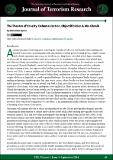Files in this item
The theatre of cruelty: dehumanization, objectification & Abu Ghraib
Item metadata
| dc.contributor.author | Spens, Christiana | |
| dc.date.accessioned | 2014-10-29T16:31:46Z | |
| dc.date.available | 2014-10-29T16:31:46Z | |
| dc.date.issued | 2014-09-30 | |
| dc.identifier.citation | Spens, C. (2014). The theatre of cruelty: dehumanization, objectification & Abu Ghraib. Journal of Terrorism Research, 5(3), pp. 49-69. | en_US |
| dc.identifier.issn | 2049-7040 | en_US |
| dc.identifier.uri | http://ojs.st-andrews.ac.uk/index.php/jtr/article/view/946 | en_US |
| dc.identifier.uri | https://hdl.handle.net/10023/5611 | |
| dc.description.abstract | A clumsy pyramid of kneeling men, naked apart from the hoods over their heads, with a smiling, fair-headed woman and a grinning man with a moustache, wearing green cleaning gloves; a slight woman with a blank expression and a man on the floor, on a limp leash; a hooded, robed figure, standing on a box with his arms outstretched and a pose similar to the crucifixion, with sinister wires behind him, and otherwise blank surroundings. A row of more hooded, naked men, forced to do sexual acts as a female prison guard (Lynndie England), tanned and wearing various shades of khaki, grins and does a thumbs up sign, pointing at him, her cigarette tilted and her expression not altogether different from Bonnie in Bonnie and Clyde. A man in uniform and a black beanie hat, sitting on an Iraqi prisoner. Another pyramid of naked detainees, with a man and women behind them, smiling arm in arm, as if they are standing by a caught wild boar or large fish, or a well-organised barbeque. The moustached man (Charles Graner), again smiling and giving a thumbs up sign, this time over a corpse, whose bloody eyes have been bandaged. A naked prisoner covering his ears, as several dogs bark at him, and soldiers watch on. Another prisoner chained to a bed-frame, with some underpants covering his face. These infamous scenes, shown in the Abu Ghraib photographs, shocked many people, and the perpetrators of the torture depicted were condemned by the relevant authorities. They transformed from clandestine mementos of hidden violence to records of an international scandal and evidence of serious crime. Their meaning changed depending on who saw them, how they were interpreted, what reactions they provoked, and the rulings of the courts regarding the people involved. They went from being private victory shots, to an international public relations disaster, to evidence of breaking of the Geneva Convention. | en_US |
| dc.language.iso | en | en_US |
| dc.publisher | Centre for the Study of Terrorism and Political Violence, University of St Andrews | en_US |
| dc.relation.ispartof | Journal of Terrorism Research | en_US |
| dc.rights | This is an open access article published in Journal of Terrorism Research. This work is licensed under a Creative Commons Attribution 3.0 License (http://creativecommons.org/licenses/by/3.0/) | en_US |
| dc.rights.uri | http://creativecommons.org/licenses/by/3.0/ | |
| dc.subject.lcc | HV6431 | en_US |
| dc.subject.lcsh | Terrorism | en_US |
| dc.title | The theatre of cruelty: dehumanization, objectification & Abu Ghraib | en_US |
| dc.type | Journal article | en_US |
| dc.description.version | https://doi.org/Publisher PDF | en_US |
| dc.publicationstatus | Published | en_US |
| dc.status | Peer reviewed | en_US |
| dc.identifier.doi | https://doi.org/http://doi.org/10.15664/jtr.946 | en |
This item appears in the following Collection(s)
Except where otherwise noted within the work, this item's licence for re-use is described as This is an open access article published in Journal of Terrorism Research. This work is licensed under a Creative Commons Attribution 3.0 License (http://creativecommons.org/licenses/by/3.0/)
Items in the St Andrews Research Repository are protected by copyright, with all rights reserved, unless otherwise indicated.


